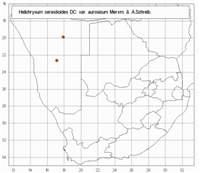Common names:
Wolbossie (A)
Origin of name:
cerastoides = resembling Cerastium (genus name from the Greek keras (horn)); referring to the shape of the seed capsule
Diagnostic characters:
Small bushy plantRosy bracts
Description:
Bushy herb, taproot woody, main branches up to c. 200 mm, erect, decumbent or prostrate, simple or branched, grey-woolly, closely leafy throughout. Leaves 5-20 x 1-4 mm, scarcely decreasing in size upwards, often patent, linear, linear-lanceolate, oblanceolate or oblong, obtuse to acute, margins more or less revolute, base broad, half-clasping, shortly decurrent, both surfaces grey-woolly. Heads heterogamous, campanulate, c. 7-10 x 6-10 mm, solitary or few clustered at the tips of very short side branches at the tips of the main branches, surrounded by leaves webbed together with wool. Involucral bracts in c. 6 series, subequal, loosely imbricate, exceeding flowers, acute to acuminate, white, pellucid and glossy below, tips white sometimes tinged rose, subopaque, radiating, outermost sometimes tinged pale golden-brown. Receptacle shortly honeycombed. Flowers 41-172, 10-36 female, 36-136 homogamous, yellow, tipped pink. Achenes 0.75 mm long, with myxogenic duplex hairs. Pappus bristles many, equaling corolla, scabrid, bases with patent cilia, not cohering.
Flowering September.
Distribution:
Hillsides and mountain tops in Namibia.
Savanna Biome.
Notes:
Two varieties are recognized:
(a) var. cerastioides (b) var. aurosicum
Distinguished from var. cerastioides by its rosy heads. Specimens from Auros, whence came the type, have the more or less linear spreading leaves typical of H. cerastioides in that region. But other specimens, for example Giess 13673 (M; PRE) and Merxm�ller & Giess 28030, (M; PRE) from the Auasberge in Windhoek district have spathulate leaves more like those of H. pumilio and indeed it is difficult to decide whether these and other specimens are better placed under H. cerastioides or under H. pumilio subsp. fleckii. The problem demands a field study, which should be extended to the serpentine rocks of the Great Dyke in Zimbabwe whence came Wild 6380 (K; M) which is scarcely to be distinguished from specimens from Auros.
Taxonomy:
Literature:
Helichrysum cerastioides DC. var. aurosicum Merxm. & Schreiber in Mitt. bot. StSamml. M�nch. 2: 328 (1957); Merxm., F.S.W.A. 139: 93 (1967).
Type:
Namibia, Grootfontein, Gaub near Auros, Rehm s.n. (M, holo.).
Synonym(s):
H. engelianum Dinter in Fedde, Repert 18: 249 (1922). Type: Namibia, Windhoek, Moltkeblick, 6 ix 1909, Engel in herbarium Dinter 1566 (K, SAM, iso.).
Vouchers:
Giess 13673 (M; PRE); Merxm�ller & Giess 28030 (M; PRE); Wild 6380 (K; M).
